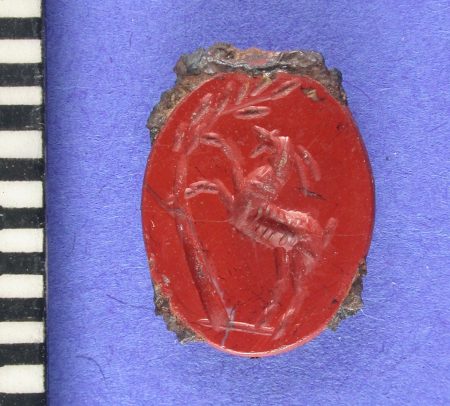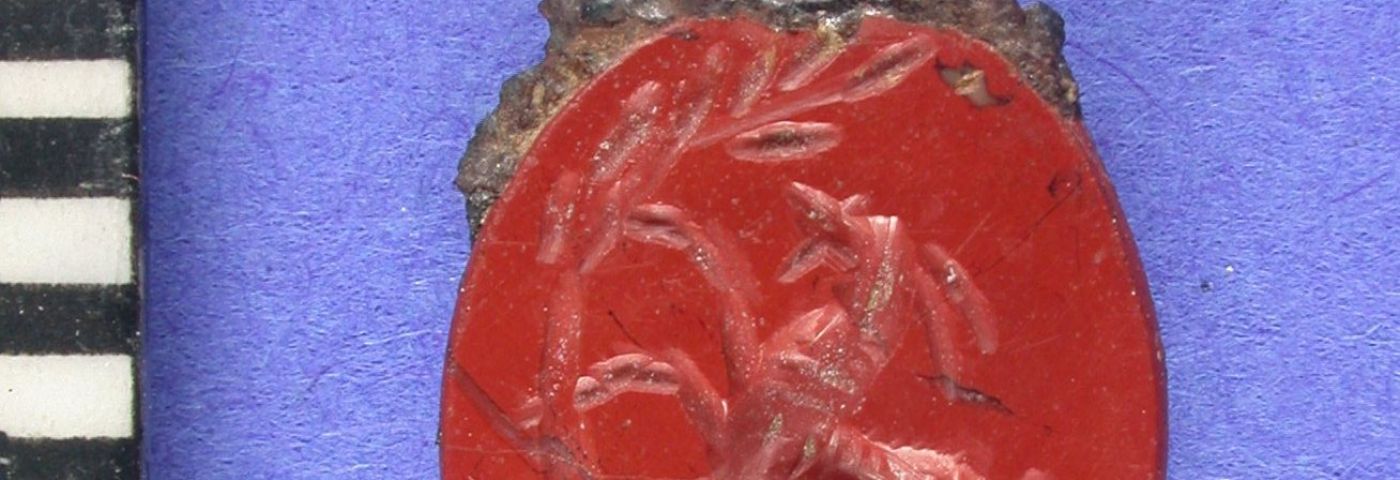Blog post by Teddy Lewis
Teddy Lewis is a recent Ancient & Modern History graduate with a focus on the Late Republic and early Empire.
Intaglios were a fairly common item in the Roman world. Incised gems recovered from Roman sites boast a wide range of materials, imagery, and symbolism, and appear to have been employed across wealth classes. An intaglio ring design was carved backwards into the material by an artisan; the design would then appear the right way round when it was impressed into a soft material like wax, leaving a raised indentation. The primary use of these rings — and in Rome they were typically rings, worn on the hands rather than as medallions or brooches — appears to have been for wax sealing. Typically items sealed would be documents or letters, with the wax showing an image associated with the sender while also demonstrating that the item had not been opened. However, references from Roman literature make it clear that anything of value might be sealed, including doors, bottles, and jars. According to Plutarch, Tiberius Gracchus placed his personal seal upon the doors of the Temple of Saturn during his fight with fellow-tribune Octavius over the passing of his agrarian reform bill. When Marcus Octavius insisted on using his tribunician veto to foil Gracchus’ attempts to hold a vote, Gracchus sealed the public treasury (aerarium) to ensure that the quaestors could not use any money until the vote was held. The imagery on an intaglio ring could become intimately and publicly associated with the wearer — for example, Augustus’ sphinx seal was well-known during his Principate, and he even left a copy of the ring for his political intimates to use in his name when he was away from Rome. On the flip side, Petronius, formerly a close friend of the emperor Nero, made sure to have his signet ring broken before committing suicide so that no one else might use his seal (and therefore his name and authority) after his death.

The significance of intaglio rings was as much symbolic as practical, and the fact that they were worn on the body meant that an intaglio might be used in any context in which the wearer found themselves. While general categories of use can be identified, this makes it difficult to determine what specific rings were used for and what they meant to the person who wore them. In excavations of cities surrounding Vesuvius, remains were recovered wearing several engraved rings at once. Not all of these rings could have been worn for sealing and not all of the images personally associated with the wearer. Certainly rings produced after the mid-first century C.E. began to see an increase in uniformity and a proliferation of similar, more mass-produced designs. The ring pictured above features a goat standing on its hind legs and grazing on a palm leaf in red jasper; rings of this kind also exist reproduced in carnelian. Although sealing appears to have been their primary use, some people may have used engraved rings simply as jewellery, or they may have collected them and used only one for legal, commercial, or epistolary purposes.
The common use of intaglio rings, whether for business or for show, is also clear from the fact that they were not only used by the very wealthiest in Roman society. Materials varied — the most popular according to the number of surviving originals was carnelian, but other semi-precious stones used include jasper, agate, amethyst, emerald, turquoise, and garnet. Many others were made of much cheaper glass, and Pliny the Elder called rings made with glass gems “the common people’s ring-stones”. This suggests both that ‘common people’ used intaglio rings and also that there was a distinction made between the price and quality of glass intaglios and ones made of semi-precious stones. Semi-precious stones were also ascribed healing or protective qualities; jasper and agate were believed to help cure disease, while Pliny writes that amethyst prevented intoxication. The intaglio depicted here is made of red jasper, which was also a popular choice for gemstone rings. The motif of the grazing goat featured on this ring may have been worn for symbolic value, or because the wearer was involved in agriculture; goats were associated with fecundity and fertility as well as the gods Bacchus and Pan. The findspot at ’the Ditches’ hillfort and Roman villa in Gloucestershire, as well as the valuable material of the ring, also point towards a wealthy owner, potentially a merchant or local aristocracy.
References:
Plutarch, and Perrin, Bernadotte. Plutarch’s Lives. Loeb Classical Library. London; Cambridge, Mass.: Heinemann: Harvard University Press, 1914.
Sagiv, Idit. Representations of Animals on Greek and Roman Engraved Gems: Meanings and Interpretations. Archaeopress, 2018. https://doi.org/10.2307/j.ctv1nzfw6v.
Lang, Jӧrn. ‘Gems, Cameos, and Social Practice’ in Cline, Lea, and Nathan T. Elkins. The Oxford Handbook of Roman Imagery and Iconography. Oxford Handbooks Online. New York, NY, 2021.
“The Ditches: The First Roman Villa in the West.” Current Archaeology, February 19, 2021. https://archaeology.co.uk/articles/features/the-ditches-the-first-roman-villa-in-the-west.htm.










